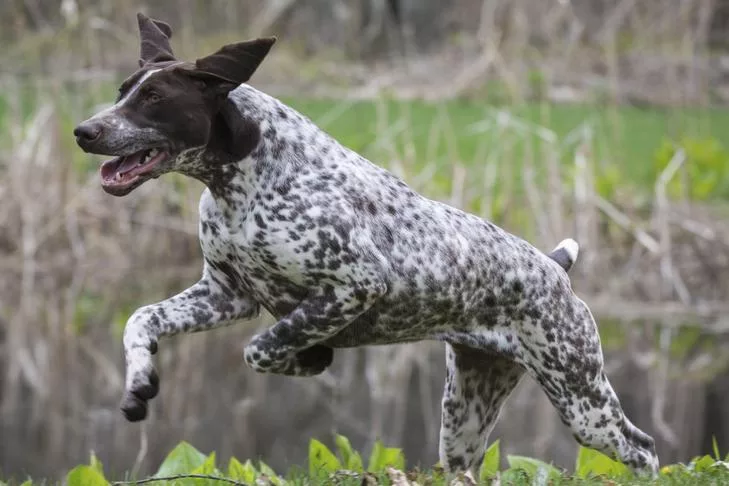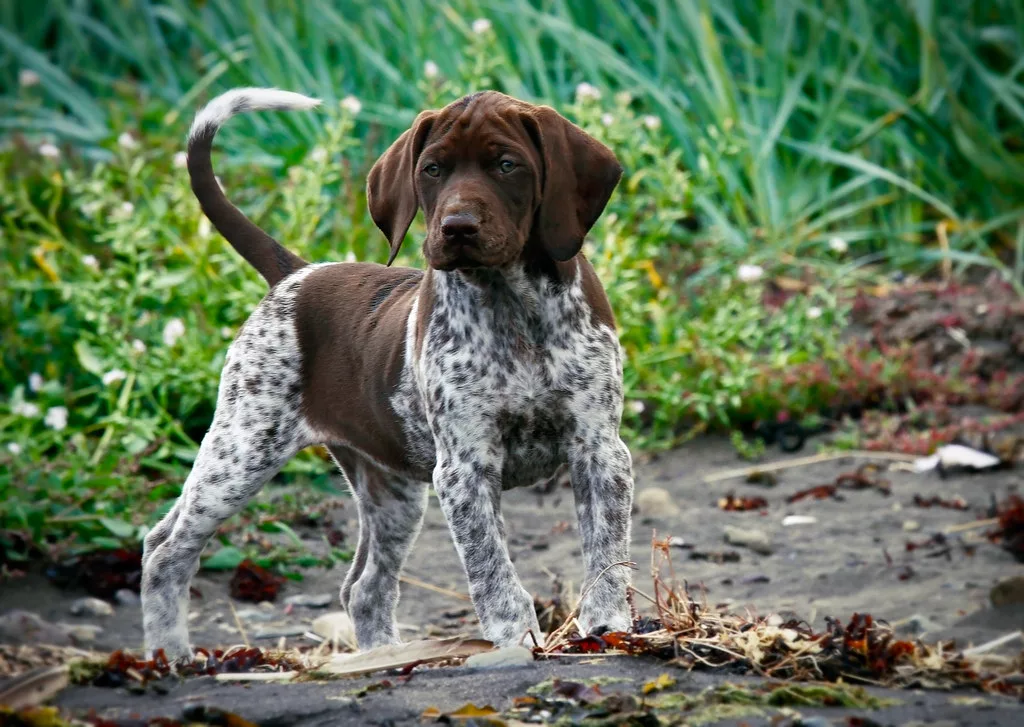The German Shorthaired Pointer (GSP) is a remarkable breed that has captured the hearts of many dog lovers. With their intelligence, trainability, and affectionate nature, it’s no wonder that they have gained popularity as both hunting dogs and companion pets. But what sets them apart from other breeds is their incredible grace and agility, making them excellent athletes. In this comprehensive guide, we will delve into the history, appearance, temperament, training, and ownership of the German Shorthaired Pointer.
History of the German Shorthaired Pointer
The GSP is a relatively young breed, developed in the 19th century in Germany. They were created by crossing several different pointers, including the English Pointer, the French Pointer, and the German Wirehaired Pointer. The goal was to create a versatile dog that could point, retrieve, and track. This resulted in a breed that excels in various tasks, making them popular among hunters and sports enthusiasts.

Origins of the German Shorthaired Pointer
The exact origins of the GSP are not entirely clear, but it is believed that they were first developed in the late 1800s by a German breeder named R. Friese. He crossed various breeds, including the Spanish Pointer, with local German scent hounds to create a dog that could excel in both pointing and tracking. Later on, other breeds such as the English Pointer and the Foxhound were added to the mix to further refine the breed.
Recognition as a Breed
The GSP was officially recognized as a breed in 1872 by the German Kennel Club. However, it wasn’t until the early 20th century that they gained recognition outside of Germany. In 1925, the breed was recognized by the American Kennel Club (AKC) and has since become a popular breed in the United States.
Role in World War II
During World War II, the GSP played a crucial role as messenger and guard dogs for the German army. Their intelligence and trainability made them ideal for these tasks. After the war, many soldiers brought GSPs back to the United States, further increasing their popularity.
Appearance
The GSP is a medium-sized dog with a sleek and muscular build. They stand at around 21-25 inches tall and weigh between 45-70 pounds. They have a short, dense coat that is typically liver and white or solid liver. The coat is easy to maintain and only requires occasional brushing to remove loose hair.

Coat Colors and Patterns
The GSP’s coat can come in various colors and patterns, including liver, black, white, and combinations of these colors. The most common color is liver and white, with the liver being a deep reddish-brown. Some GSPs may also have ticking, which is small spots of color on a white background. Ticking can be found on any part of the body, but it is most commonly seen on the legs and chest.
Physical Features
GSPs have long, floppy ears and a long, thin tail. Their ears are set high on their head and hang down close to their cheeks. The tail is usually docked to about two-thirds of its original length, but this practice is becoming less common. GSPs also have webbed feet, which makes them excellent swimmers.
Health Concerns
Like all breeds, GSPs are prone to certain health issues. These include hip dysplasia, bloat, and eye problems such as cataracts and progressive retinal atrophy. It is essential to research the breeder and ensure that they conduct health screenings on their breeding dogs to reduce the risk of these health concerns.
Temperament
GSPs are intelligent, energetic, and playful dogs. They have a strong desire to please their owners and are very affectionate towards their families. They are also known for their loyalty and make excellent watchdogs. However, their high energy levels and need for mental stimulation can make them destructive if left alone for long periods.

Good with Children
GSPs are generally good with children, but they can be boisterous and may accidentally knock over small children. It is essential to supervise interactions between GSPs and young children to prevent any accidents. Early socialization and training can also help GSPs learn how to interact appropriately with children.
Socialization and Training
Socialization is crucial for GSPs as they can be wary of strangers. Introducing them to different people, animals, and environments from a young age will help them become well-adjusted adults. Training is also essential for GSPs as they are highly trainable dogs. Positive reinforcement methods work best with this breed, as they respond well to praise and treats.
Training
As mentioned earlier, GSPs are highly trainable dogs. They are eager to please their owners and respond well to positive reinforcement training. Here are some tips for training your GSP:
- Start training early: GSPs are intelligent and can quickly pick up on commands, so it’s best to start training them as soon as possible.
- Use positive reinforcement: Reward-based training works best with GSPs. Praise, treats, and toys are all great motivators for this breed.
- Be consistent: GSPs thrive on routine, so it’s essential to be consistent with your training methods and expectations.
- Keep training sessions short: GSPs have a short attention span, so keep training sessions short and engaging to prevent them from getting bored.
- Socialize your GSP: As mentioned earlier, socialization is crucial for GSPs. Expose them to different people, animals, and environments to help them become well-adjusted adults.
Training for Hunting
GSPs were originally bred as hunting dogs, and they excel in this field. They have a keen sense of smell and are excellent at tracking and retrieving. Here are some tips for training your GSP for hunting:
- Start early: It’s best to start training your GSP for hunting from a young age. This will allow them to develop their natural instincts and abilities.
- Use positive reinforcement: As with any training, positive reinforcement works best with GSPs. Praise and treats can be used to reinforce desired behaviors.
- Introduce them to different game: GSPs can hunt a variety of game, including birds, rabbits, and deer. Introduce them to different types of game to see which they excel at.
- Train for specific tasks: GSPs can be trained for specific tasks such as pointing, flushing, and retrieving. Determine which tasks you want your GSP to perform and train them accordingly.
- Practice obedience: Obedience is crucial for hunting dogs, as they need to follow commands and stay focused on the task at hand. Incorporate obedience training into your hunting training sessions.

Ownership
Owning a GSP is a big responsibility, and it’s essential to understand what it takes to provide a happy and healthy life for your dog. Here are some things to consider before bringing a GSP into your home:
- Exercise requirements: GSPs are high-energy dogs that require plenty of exercise. They are not suitable for apartment living and do best in homes with large yards or access to open spaces.
- Mental stimulation: In addition to physical exercise, GSPs also need mental stimulation to prevent boredom and destructive behavior. Puzzle toys, training sessions, and interactive games are all great ways to keep your GSP mentally stimulated.
- Grooming: GSPs have a short, low-maintenance coat that only requires occasional brushing. However, they do shed, so be prepared to vacuum regularly.
- Health care: As with any dog, GSPs require regular vet check-ups, vaccinations, and preventative care such as flea and tick treatments.
- Time commitment: GSPs are not suitable for owners who are away from home for long periods. They thrive on human companionship and can become destructive if left alone for too long.
Finding a Reputable Breeder
When looking for a GSP, it’s essential to find a reputable breeder who prioritizes the health and well-being of their dogs. Here are some things to look for in a breeder:
- Health screenings: A responsible breeder will conduct health screenings on their breeding dogs to ensure that they are not passing on any hereditary health issues to their puppies.
- Socialization: A good breeder will socialize their puppies from a young age, exposing them to different people, animals, and environments.
- Knowledgeable about the breed: A reputable breeder will have extensive knowledge about the breed and be able to answer any questions you may have.
- Willing to provide references: A good breeder will be happy to provide references from previous puppy buyers.
- Contract and health guarantee: A responsible breeder will provide a contract and health guarantee for their puppies.
Video
Conclusion
The German Shorthaired Pointer is a remarkable breed that excels in various tasks, from hunting to being a loving companion. Their intelligence, trainability, and affectionate nature make them a popular choice among dog owners. However, owning a GSP is a big responsibility, and it’s essential to understand their history, appearance, temperament, training, and ownership requirements before bringing one into your home. With proper care, training, and socialization, the GSP will make a loyal and loving companion for many years to come.